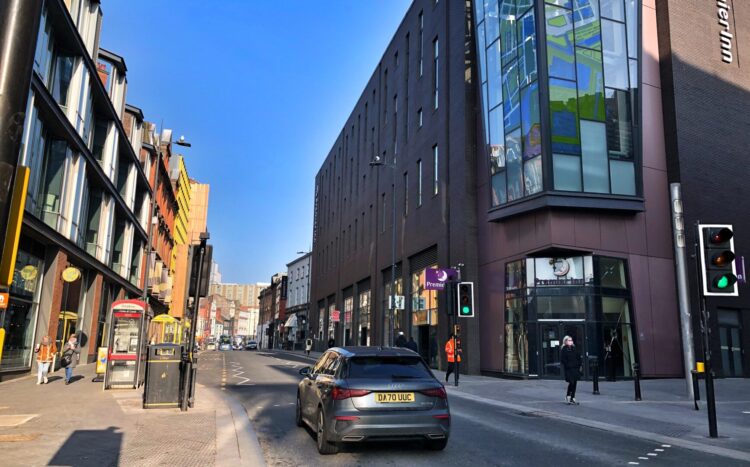Liverpool businessman Dougal Paver considers the pros and cons of introducing a congestion charge to Liverpool city centre and what the economic impact could be

Hands up who fancies developing asthma? Thought not. And who would like to lose their job? No, me neither.
And there, in stark terms, were the binary choices playing out on social media over the weekend as news emerged of Liverpool council’s plans to debate the introduction of a congestion charge in the city centre.
The aim of cleaner air and a more balanced, pedestrian-friendly city centre is both laudable and, when implemented with the right level of investment in public realm and strategic infrastructure, highly successful. We’ve done it already in Liverpool, remember: just look at Castle Street any sunny day, or most of the Liverpool ONE estate.
Fears of a rapid and arbitrary introduction of charges, however, set the Liverpool Echo’s comment sections alight.
Readers’ concerns were clear. People fear such a move would have a dramatic, immediate and long-term impact on the discretionary use of the city centre, with a major knock-on effect on jobs in the tourism, leisure and retail sectors.
Why voluntarily bring the city’s 25-year regeneration streak to a juddering halt, they asked – particularly when the job is by no means finished? Employers even put their heads above the parapet and said ‘if this happens I’m taking my jobs elsewhere’.
And all this at a time when we need to re-build the city’s economy after the pandemic and encourage the return of tourists and their spending power. Few folk like visiting a ghost town, people noted, and there’s a big enough challenge attracting back those workers now adapted to home-working.
The key word here, of course, is ‘choice’.
Humans make choices in their own interest and Liverpudlians are no different: if it’s not to our financial liking to use Liverpool city centre then we’ll drive to Speke or Edge Lane or further still, to Southport or Chester.
Commuters not near rail or bus facilities will lobby their bosses to continue working from home. And the jobs in the shops, cafes, pubs, restaurants and bars that so enliven our city centre will follow them.
The key lies in investing ahead of the issue so that you can nudge behaviour towards the end goal, rather than compelling change overnight with the blunt instrument of a tax that people can avoid by the simple expedient of driving to Cheshire Oaks. Great for job creation in Cheshire West; devastating for Liverpool.
In Manchester they had a vote on the issue in 2008. The plans were quietly shelved after they were rejected by 79% of the electorate on a large turn-out. Will Liverpudlians be offered a referendum? That remains to be seen, but for something so critical I’d argue that we should.
Amsterdam offers an instructive case study: by investing strategically in an integrated bus, ferry, tram and metro system, together with comprehensive cycleways, the city’s balance of traffic movements is 32% by bicycle, 22% by car and 16% by public transport (the balance being made up by taxis and freight).
In the city centre, 48% of traffic movement is by bike – and yet there is no congestion charge. Incentive rather than compulsion seems to work rather well over there.
Liverpool already has a comprehensive bus network and the second largest metro rail system in the country, with 68 stations.
Both are very good and popular with commuters. There are ferries, too, albeit more totems for our tourism industry rather than serious commuter assets. You should see how the rapid transit boats are used in Amsterdam, by contrast.
There are a few obvious traffic pinch-points in the city centre, but that aside, moving around Liverpool is generally straightforward. Try our twin city, Dublin: same sized conurbation but a nightmare to get around.
The challenge for Liverpool council, of course, is that its budgets have been so denuded by years of cuts from central government that the capital is simply not there to support the long-term strategic investments of the sort Amsterdam has made.

Many Echo readers saw the congestion charge as nothing more than a tax-grab to plug budget gaps on the naïve assumption that everyone would comply, rather than exercise their freedom of choice and go elsewhere.
That is unfair: this debate has been forced on the council by Government targets to improve air quality. But on the accepted basis that no city or state has ever taxed itself to prosperity, we must hope this is debated fully and any measures introduced carefully and under full advisement.
Because now that the funding model for local authorities is based on them retaining their business rates, the strategic risk facing the council is that the measure kills off more ratepayers and their rateable income than it raises in revenue.
We won’t know unless and until it is implemented, of course, but after so many hard political yards by all parties to get the city where it now is, I can’t help but feel we’re in danger of turning the wrong way down a one-way street marked Decline.
Whatever political avenues are open to Liverpool council, the city-region mayor and Merseytravel to secure large-scale infrastructure funding from Whitehall to help with its clean air ambitions, the business community needs to get foursquare behind them in their bids.
Allowing the city centre to wither on the vine after decades of progress would be folly, and Government must be left in no doubt how we feel about that.
Dougal Paver is a former non-executive director of regeneration agency Liverpool Vision and a former board member of Liverpool Chamber of Commerce. As managing director of Merrion Strategy he advises developers on investment projects across the UK from his base in south Liverpool.

